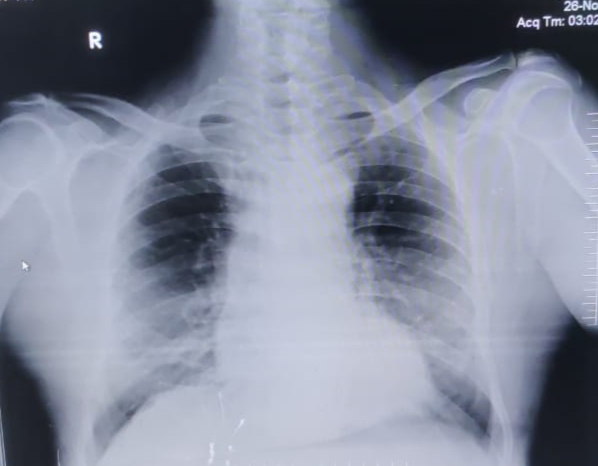INTERNSHIP ASSESSMENT
ICU & AMC DUTY:
- Monitored vitals of all pts hourly
- Maintenance of ventilator settings as guided by PGs.
- Taken 5 ABG (3 radial and 2 femoral)
- Learnt how to manage in critical situations
- Assisted in intubation and central line under guidance of Dr.chandana(pgy3) ma'am
- Ryles have been put for 1 patients
- CPR done for 2 patients
- Foleys have been put for 2 patients (2 male pts)
-Learned how to maintain GRBS in a hypoglycaemic patient using 25-D
NEPHRO DUTY:
- monitored patients who came for dialysis
- Handled Day care patients who came for dialysis.
- Learnt about dialysis machine and what all infections a pt can get by not maintaining proper hygiene of the central line
- Learned how fistulas are life saving for pts who come for dialysis
- Assisted my PG in putting central line
-Have learnt how to give NTG to the patients and gave for 3 patients
- Have learnt how to maintain patients BP and GRBS while dialysis is going on
WARD DUTY :
- Helped my co interns in putting SOAP notes
-Attended clinical lecture hall discussions and recorded videos
- Helped our long distance patients by taking them to referrals
- Helped UGs by alloting them cases
PSYCHIATRY POSTINGS :
-Learnt about diseases like:
1. Depression
2.Schizophrenia
3.ALCOHOL DEPENDENCE SYNDROME
4. TOBBACO DEPENDENCE SYNDROME
5. OCD
6. Psychosis
7. Panic attack
8.Bipolar disorder
-learnt the medications given to the patients and their side effects
-Went for DAC saw how pgs interact with the patients
-Learnt the tapering of drugs like lorazepam.
UNIT DUTY:
1)http://157siddhanth.blogspot.com/2022/10/70-year-old-male-came-to-casualty-with.html
Brief history:
This is a case of chronic alcoholic who meet with a trauma, leading to inability to walk and slurred speech
Diagnosis:
Cerebellar stroke (left cerebellar infract)
? Alcohol withdrawals (delirium tremens)
?Cardioembolic stroke.
? Wernickes Korsakoff syndrome
?alcoholic liver disease
Learning points:
1.what is delirium tremens?
Ans.Delirium tremens, also called DTs or alcohol withdrawal delirium (AWD), is a severe type of withdrawal from alcohol. It usually starts about 2 to 3 days after someone who’s dependent on alcohol ends a long drinking binge.
DTs usually lasts for 2 to 3 days, but symptoms may linger for as long as a week.
About 5% of people in alcohol withdrawal get DTs. If untreated, delirium tremens can cause a heart attack, stroke, and death.
2.what is wernicke-korsakoff syndrome?
Ans.Wernicke's encephalopathy is a degenerative brain disorder caused by the lack of thiamine (vitamin B1). It may result from alcohol abuse, dietary deficiencies, prolonged vomiting, eating disorders, or the effects of chemotherapy. B1 deficiency causes damage to the brain's thalamus and hypothalamus. Symptoms include mental confusion, vision problems, coma, hypothermia, low blood pressure, and lack of muscle coordination (ataxia). Korsakoff syndrome (also called Korsakoff's amnesic syndrome) is a memory disorder that results from vitamin B1 deficiency and is associated with alcoholism. Korsakoff's syndrome damages nerve cells and supporting cells in the brain and spinal cord, as well as the part of the brain involved with memory. Symptoms include amnesia, tremor, coma, disorientation, and vision problems, The disorder's main features are problems in acquiring new information or establishing new memories, and in retrieving previous memories. Although Wernicke's and Korsakoff's are related disorders, some scientists believe them to be different stages of the same disorder, which is called Wernicke-Korsakoff syndrome. Wernicke's encephalopathy represents the "acute" phase of the disorder and Korsakoff's amnesic syndrome represents the disorder progressing to a "chronic" or long-lasting stage.
https://www.ninds.nih.gov/health-information/disorders/wernicke-korsakoff-syndrome
2)http://157siddhanth.blogspot.com/2022/10/34-year-old-female-with-seizure-attack.html
Brief history:
She was a k/c/o Epilepsy(not on regular medications) came to OPD with involuntary movements of both upper limb and lower limbs 2 episodes lasted for 2 mins post ictal confusion+ and tongue bite+ and change is her voice after seizure episode
Learning points:
-On Performing CNS examination saw hypereflexia
-The epilepsy-aphasia spectrum is a group of conditions that have overlapping signs and symptoms. A key feature of these conditions is impairment of language skills (aphasia). The language problems can affect speaking, reading, and writing. Another feature of epilepsy-aphasia spectrum disorders is certain patterns of abnormal electrical activity in the brain, which are detected by a test called an electroencephalogram (EEG). Many people with conditions in this spectrum develop recurrent seizures (epilepsy), and some have mild to severe intellectual disability. The conditions in the epilepsy-aphasia spectrum, which all begin in childhood, include Landau-Kleffner syndrome (LKS), epileptic encephalopathy with continuous spike-and-wave during sleep syndrome (ECSWS), autosomal dominant rolandic epilepsy with speech dyspraxia (ADRESD), intermediate epilepsy-aphasia disorder (IEAD), atypical childhood epilepsy with centrotemporal spikes (ACECTS), and childhood epilepsy with centrotemporal spikes (CECTS).
Source:https://medlineplus.gov/genetics/condition/epilepsy-aphasia-spectrum/
3)http://157siddhanth.blogspot.com/2022/10/this-is-a-online-e-log-book-to-discuss.html
1)Difference between central and peripheral vertigo ?
Ans.Peripheral vertigo arises due to conditions that damage the vestibular apparatus or the vestibular nerve, such as benign positional paroxysmal vertigo, vestibular neuritis, labyrinthitis, Méniére's disease, and acoustic neuroma.
In contrast, central vertigo can result from
damage to the vestibular structures in the
brainstem or cerebellum that can occur from the ischemic posterior circulation stroke, vertebrobasilar insufficiency, multiple sclerosis, and certain brain tumors (e.g. pilocytic astrocytoma).
When it comes to signs and symptoms,
nystagmus is the most important one to
remember. It can appear at rest or be provoked by the Dix-Hallpike maneuver. Nystagmus appears in both peripheral and central vertigo, but there are some nuances that can help you differentiate between the two. In central vertigo, nystagmus can be horizontal, rotatory, and vertical. If provoked, there is usually no lag time between the Dix-Hallpike maneuver and the onset of nystagmus. It usually lasts more than 1 minute.


Comments
Post a Comment